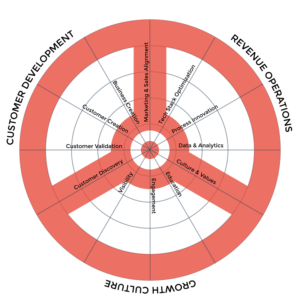During the last two decades the landscape for starting and growing new businesses, brands, and products has changed profoundly. A renaissance in entrepreneurship and intrapreneurship has been fueled by two forces: the evolution of SaaS (including automation and machine learning) and business management innovation. With so many powerful tools and methods for growing businesses, the primary business growth challenge has become how to integrate these ideas and resources.
During this time, we’ve seen a remarkable change in core business functions. Market research and product development have evolved from focus groups and surveys to the customer development and lean startup methods of today. Business intelligence has evolved from OLAP and data warehouses to data lakes, data visualization, and citizen data scientists. And sales and marketing have matured from expensive and inefficient blunt-force broadcast techniques to highly-efficient, scalable, and personalized buying experiences driven by automation and machine learning. Even the way we manage business has changed with many organizations developing values-based cultures designed to instill a greater sense of purpose in associates and elicit higher levels of contribution as a result.
So, with all of these methods and tools at our disposal, starting and/or growing a business should be easy, right? Paradoxically, the answer is, often, no. The business growth challenge has shifted from the acquisition of resources such as capital and talent to the orchestration of resources. Entrepreneurs and business leaders who can best navigate the ever-changing landscape of technology, process, and leadership innovation will be better positioned to create products and services customers desire and company cultures employees value.
To Grow and Develop Businesses Today, We Need Integrative Frameworks
The success of a business is largely determined by three factors:
- Has the company found product-market fit?
- Do customers like the buying experience?
- Are the company’s associates aligned and engaged?
A range of excellent systems and tools have been developed in each of these areas. Steve Blank’s Customer Development framework, the Lean Startup movement initiated by Eric Ries, his protege, and Clayton Christensen’s Jobs to be Done model all substantially improve the likelihood of finding product-market fit. Contextual marketing and inbound marketing tools and methods help create buying experiences that are educational, personalized, and positive. And systems like the Entrepreneurial Operating System and Open Book Management foster workplace environments with clear values, aligned goals, and empowered team members.
However, how and when organizations adopt these resources and techniques is a fundamental driver of their impact. Sales and marketing technology is a good example. Licensing a top-tier marketing automation platform and retaining an agency to help fuel content development and manage SEO and PPC is, at a minimum, a $100,000 annual commitment before paid advertising costs are added (and can scale much higher, very quickly). If these costs are taken on before product-market fit is validated, the results can be devastating. Beyond the loss of financial resources, the company loses something equally precious: time, runway, and credibility with customers and investors.
Similarly, fully leveraging these powerful platforms can be difficult without strong alignment between sales and marketing teams. Without a shared understanding of customer personas, ideal customer profiles, lead and deal stages, and mutual service level agreements, the ephemeral initial interest of prospects often evaporates into indifference and the company is relegated to the junk folder.
A Diagnostic Model for Business Growth
If we accept the premise that business growth is driven primarily by the three factors of product-market fit, buying experience, and internal company alignment, it makes sense to integrate the best ideas, technologies, and toolsets from these areas into a diagnostic and prescriptive guide for business growth. While each of these areas addressed individually improves business strategy and execution, together they create an even more effective roadmap for SMBs. For example:
- The emerging Revenue Operations framework for aligning teams, technology, and sales and marketing processes surfaces important considerations during the customer creation phase of the Customer Development process.
- During the company building process, systems like EOS help companies establish fundamental clarity around values and goals which drive better hiring decisions and internal alignment.
- As Sales and Marketing teams navigate an ever-growing landscape of salestech and martech solutions, embedding lessons from customer development and jobs to be done helps assure that a deep understanding of the customer is never overshadowed by the implementation and orchestration of technology platforms and tools.
At Revenue Refinery, we believe one such model can be created using the pillars of customer development, revenue operations, and growth culture development.
Customer Development
Customer development is an evidence-based method for finding product-market fit. It is made up of the following four stages:
- Customer Discovery is the process of validating hypotheses regarding the target buyer’s needs and the ability of a product concept to satisfy them.
- Customer Validation is the process of understanding who in each organization will influence the sale, the sales cycle duration, the financial model, and obtaining initial early adopters.
- Customer Creation involves developing initial demand creation strategies based on an understanding of the target market and competitive landscape.
- Business Creation is the final stage during which talent is hired, processes defined and documented, and organizational culture articulated.
Customer development is a powerful alternative to the “build it and they will come” mindset that dooms many new product initiatives.
Revenue Operations
Revenue Operations is an emerging framework intended to align the efforts of all parties who impact the customer journey including (at a minimum) product, marketing, sales, and customer service. While sales operations and marketing operations roles have become increasingly valued in recent years, the complexity that has developed from managing an ever-increasing range of SaaS platforms and tools often leads to disconnects between functions which undermine the buying experience. Because revenue operations views the buyer as the fundamental point of focus rather than the functional area, it aligns teams and technology across functions to create an integrated, positive buying experience for the customer which bolsters sales and revenue for the company.
In practice, revenue operations encompasses four primary areas:
- Management & strategy
- Process optimization
- Technology & project management
- Data & analytics
When these four foundational areas are managed together in order to create an ideal customer experience, substantial value is created for the customer and the organization.
Growth Culture Development
At Inbound 2017, HubSpot co-founder Dharmesh Shah described a conversation with Elon Musk in which he asked the latter about how organizations like SpaceX solve such large and difficult problems. In his response, Musk compared a company’s employees to vectors; both have direction and magnitude. When the directions and abilities of team members are aligned, the company is able to accomplish more. Without alignment, people working at cross purposes can cancel out their respective contributions.
While there are a number of very good systems for aligning talent within organizations, there tend to be four common factors:
- Defining and operating by a set of core values
- Educating associates on what drives the success of the business
- Engaging team members through empowerment and respect
- Creating a shared sense of progress toward goals through public metrics
When customer development, revenue operations, growth culture development, and their 12 respective areas of focus are integrated, a powerful framework emerges for diagnosing growth challenges:

Revenue Refinery’s Growth Readiness Assessment & Diagnostic (or GRAD, as we like to call it) indexes companies along 48 dimensions (4 subdimensions within each of the 12 dimensions we’ve discussed) and produces composite scores for the areas of customer development, revenue operations, and growth culture development. In doing so, it identifies low-indexing areas that often represent primary barriers to growth and opportunities for improvement.
While this is only one way that these powerful frameworks can be integrated, it illustrates how organizations can combine strategic and operational aspects of their business into diagnostic tools which can identify bottlenecks to growth.
In a new twelve-part series, we’ll take a deeper dive into each of these areas and consider how they inform business growth readiness. Read the first installment here: Validating Problems and Products with Customer Discovery.

